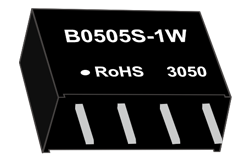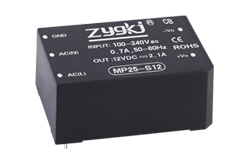news
Converting 12V AC to DC for LED manufacture: An Efficient Solution
Author: ZYG Power Module Time: 2023-7-31
Introduction:
LEDs (Light Emitting Diodes) have become increasingly popular due to their energy efficiency and durability. However, one challenge in utilizing LEDs is the need to convert the alternating current (AC) power source to direct current (DC) for their operation. In this article, we will explore an efficient solution for converting 12V AC to DC for LED applications, highlighting its benefits and implementation.
Understanding the Need for Conversion:
While LEDs are designed to operate on low voltage DC power, the main power supply in most households and commercial buildings is AC power. Therefore, it is necessary to convert the incoming AC power to DC in order to power LEDs efficiently and effectively. This conversion process involves eliminating the negative half-cycles of the AC waveform and converting it to a continuous flow of current with a constant polarity.
The Challenges of Converting 12V AC to DC:
Converting 12V AC to DC presents unique challenges that must be addressed. One primary concern is the voltage drop that occurs during the conversion process. Since LEDs require a specific voltage to operate optimally, any significant voltage drop can lead to reduced brightness and performance. Additionally, the conversion process must be efficient to minimize energy loss and ensure the longevity of the LED.
An Efficient Solution: The Bridge Rectifier Circuit:
One widely used solution for converting 12V AC to DC for LED applications is the bridge rectifier circuit. This circuit consists of four diodes arranged in a bridge configuration, allowing it to convert the AC voltage to DC effectively. The bridge rectifier circuit is highly efficient, as it utilizes all parts of the AC waveform and eliminates the need for additional components like transformers.
Implementation of the Bridge Rectifier Circuit:
To implement the bridge rectifier circuit for converting 12V AC to DC, the following steps can be followed:
1. Identify the input voltage: Determine the voltage of the AC power source, ensuring it is within the acceptable range for the bridge rectifier circuit.
2. Select appropriate diodes: Choose four diodes capable of handling the input voltage and current. It is important to consider their forward voltage drop and reverse leakage current specifications.
3. Connect the diodes: Connect the diodes in a bridge configuration, ensuring the correct polarity. This configuration allows the diodes to conduct current in alternating directions during each half-cycle of the AC waveform.
4. Connect the load: Connect the LED load to the output of the bridge rectifier circuit. It is crucial to ensure the polarity is correct to prevent damage to the LEDs.

Benefits of Using the Bridge Rectifier Circuit:
The bridge rectifier circuit offers several advantages for converting 12V AC to DC for LED applications:
1. High efficiency: The bridge rectifier circuit efficiently converts AC power to DC power, minimizing energy loss during the conversion process.
2. Cost-effective: The bridge rectifier circuit eliminates the need for additional components like transformers, making it a cost-effective solution.
3. Compact size: The bridge rectifier circuit is relatively small in size, allowing for easy integration into LED lighting fixtures and other applications.
Conclusion:
Converting 12V AC to DC for LED applications is a crucial step in utilizing LEDs effectively. The bridge rectifier circuit provides an efficient and cost-effective solution for this conversion process. By understanding the challenges involved and implementing the bridge rectifier circuit correctly, LED users can ensure optimal performance and longevity of their lighting systems.
Precedente: China SP Series wholesale : An AC DC Converter for Efficient Power Conversion
Prossimo: Cheap SP Series wholesale: The Ultimate AC DC Converter Solution
informazioni rilevanti
-
2023-8-31
The Electrifying Power Series: Unleashing the Potential of Electricity
Introduction Electricity is an integral part of our lives, powering our homes, industries, and transportation systems. It is a form of energy that has revolutionized the way we live and has become the backbone of modern society. In this article, we will explore the electrifying power series, which aims to unleash the full potential of electricity. Chapter 1: The History of Electricity To understand the potential of electricity, we must first delve into its history. The discovery of electricity dates back to ancient times, with the observation of static electricity by the Greeks and the invention of the Leyden jar by a Dutch physicist in the 18th century. However, it was not until the late 19th century that electricity became...
Visualizza dettagli -
2023-6-8
How to Convert 110V AC to 12 Volt DC?
Converting 110V AC to 12 Volt DC can be a bit tricky, especially if you're not familiar with electrical work. But with the right tools and knowledge, it can be done safely and efficiently. In this article, we'll take a closer look at the steps involved in converting 110V AC to 12 Volt DC. Step 1: Understand the Basics Before you even begin the process of converting 110V AC to 12 Volt DC, it's important to have a basic understanding of how electricity works. AC, or alternating current, is the type of electricity that comes out of your wall outlets. DC, or direct current, is the type of electricity that is used to power many electronic devices. In order to...
Visualizza dettagli -
2023-8-11
Custom Type Power Series: Unleashing the Potential of Personalized Products
In today's consumer-driven world, customization has become a powerful tool for businesses to differentiate themselves and meet the unique preferences of their customers. Whether it is personalized clothing, customized accessories, or tailor-made furniture, consumers are increasingly seeking products that reflect their individuality and cater to their specific needs. This has given rise to the custom type power series, revolutionizing the way products are created and consumed. The custom type power series takes customization to a whole new level by allowing customers to design and personalize their products from scratch. From choosing the materials, colors, and patterns to adding their own style and flair, the possibilities are endless. This not only empowers customers to have a say in the creation process...
Visualizza dettagli -
2023-5-8
AC-DC Power Supply: Efficient and Reliable Energy Conversion Solution
An AC-DC power supply is a device that converts alternating current (AC) into direct current (DC) to power electronic devices. It is used in a wide range of applications, including computers, televisions, and other consumer electronics, as well as industrial and medical equipment. The main advantage of an AC-DC power supply is that it provides a more efficient and reliable energy conversion solution compared to other types of power supplies. The efficiency of an AC-DC power supply is achieved through the use of modern power electronics and control techniques. These techniques allow for the conversion of AC power to DC power with minimal loss of energy. The efficiency of a power supply is measured by its power conversion efficiency, which...
Visualizza dettagli -
2023-10-20
Comparing Modular and Non-modular Power Supplies: Which is Right for You?
When building a computer or upgrading its components, one crucial consideration is the power supply unit (PSU). The PSU is responsible for converting AC power from the wall outlet into DC power that the computer's components can utilize. It provides a steady and reliable power source to ensure the stability and longevity of your computer system. When it comes to choosing a power supply unit, one important factor to consider is whether to opt for a modular or non-modular design. Each has its own advantages and disadvantages, and understanding them can help you make an informed decision. First, let's define what modular and non-modular power supplies are. A non-modular power supply comes with a fixed set of cables permanently attached...
Visualizza dettagli -
2023-4-15
Convertitore CA-CC: conversione della corrente alternata in corrente continua
AC-DC converters, also known as rectifiers, are electronic devices that convert alternating current (AC) to direct current (DC). They are widely used in a variety of applications, including power supplies, battery chargers, and motor drives. In this article, we will explore the basics of AC-DC converters, their types, and their uses. Alternating current (AC) is a type of electrical current that reverses its direction of flow at regular intervals. This is usually represented by a sine wave, where the current alternates between positive and negative values. In contrast, direct current (DC) flows in only one direction and remains constant. The main purpose of an AC-DC converter is to convert the AC voltage into a DC voltage. This is done by...
Visualizza dettagli


















